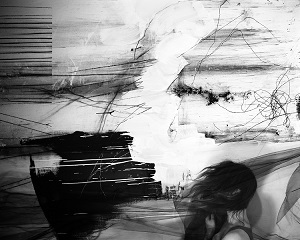
Born Detroit, 1981/BA, Lawrence University, Appleton, Wisconsin/MFA, Cranbrook Academy of Art, Bloomfield Hills, Michigan/Lives in Hamtramck, Michigan
Lauren Semivan’s enigmatic, tour de force black and white photographs—no color, no digital—are shot with an early 20th century, large-format, tripod-mounted camera. The realization of her mystifying tableaus entails sheets of film, reams of negatives, and even the use of a home darkroom. Semivan’s retardataire, hands-on practice is akin to other recent throwbacks that captivate millennials and boomers alike, including old fashioned acoustic instruments, vinyl, and flip phones.
Semivan’s images are, however, quintessentially contemporary inventions. Despite the cumbersome, antique equipment, her interdisciplinary mosaics of abstraction, process and performative procedures, staged (or set-up) scenes, and her pictorial perception of the oft thrumming tensions between conscious and subconscious states of mind, yield psychodramas at once rational and irrational. Her artist statements, albeit tinged with surrealist overtones, reiterate the unease aroused by her photographs: “The images often contain something of the everyday to ground them, juxtaposed with something extraordinary or out of the world to set them free from the realm of the everyday. I use my own body within the work to anchor the images within a place of dreams and personal emotions.” Decidedly not the lingo of a straight or “decisive moment” photographer. Her teachers at Wisconsin’s Lawrence University, Julie Lindemann and John Shimon, plus critic Lyle Rexer (The Edge of Vision: The Rise of Abstraction in Photography, 2009), were particularly influential on the evolution of Semivan’s sensibility.
Continue reading →



















